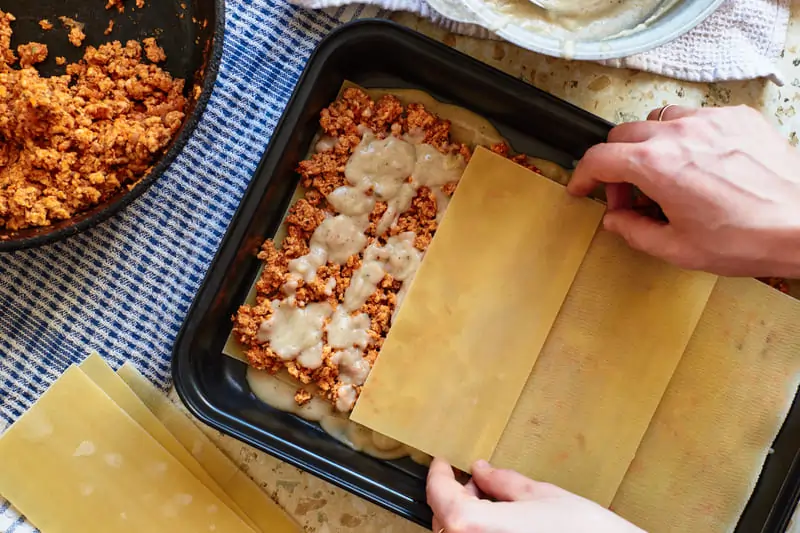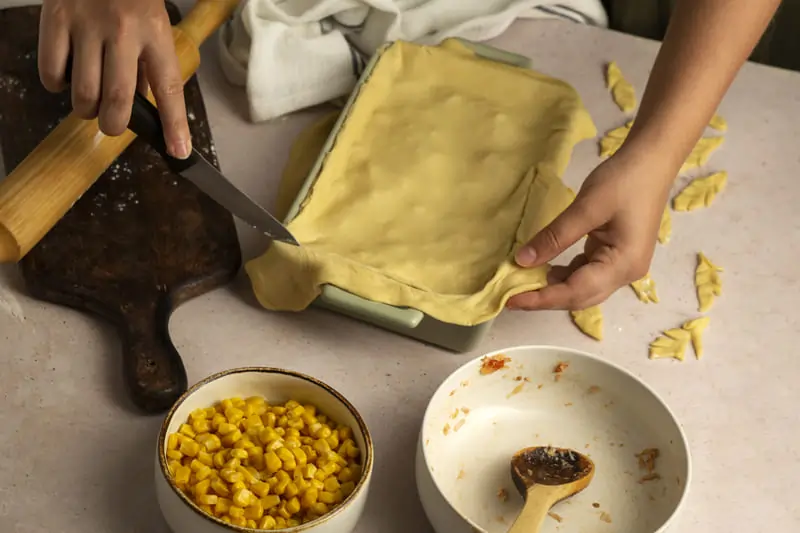Lasagna is a versatile dish loved for its rich layers of pasta, sauce, and cheese. A common question among home cooks is whether Barilla lasagna sheets need to be boiled before assembling the dish. With the popularity of oven-ready lasagna sheets, understanding the preparation process is essential for perfect results. Let’s explore when boiling is necessary, how to use Barilla lasagna sheets, and the best practices for cooking.
Types of Barilla Lasagna Sheets
1. Oven-Ready Lasagna Sheets
Barilla created its oven-ready lasagna sheets to simplify preparation, making them a go-to choice for busy home cooks. Since these sheets are pre-cooked and dried, they eliminate the need for boiling before assembly. During baking, they absorb moisture from the sauces and fillings, softening perfectly while saving time and effort.
To use oven-ready sheets effectively, choose a sauce with enough moisture to help them cook evenly. The right amount of sauce ensures the sheets become tender and integrate seamlessly into the lasagna. These sheets work best in recipes featuring rich marinara or béchamel sauces, as they absorb the flavors beautifully, enhancing the overall taste. For practical guidance, explore this simple oven-ready Barilla lasagna recipe.
2. Traditional Lasagna Sheets
Barilla also offers traditional lasagna sheets for those who enjoy a more hands-on cooking process. These sheets require boiling before layering, which gives them a firmer texture that withstands longer baking times. Recipes that use lower temperatures or extended cooking durations benefit from the structure traditional sheets provide, preventing them from becoming overly soft.
When boiling traditional sheets, avoid overcooking them to preserve their firm texture. After draining, lay the sheets flat on a clean towel to prevent sticking and tearing. Their sturdiness makes them an excellent choice for lasagnas with chunky meat sauces or hearty vegetable fillings, as they support multi-layered creations with ease. For detailed recipes using traditional sheets, check out this classic Barilla lasagna recipe.
By understanding the differences between Barilla’s oven-ready and traditional lasagna sheets, you can select the best option to suit your recipe and cooking style, ensuring delicious and consistent results every time.
Choosing the Right Lasagna Sheet for Your Dish
Selecting between oven-ready and traditional sheets depends on your recipe, cooking time, and desired texture. If convenience and speed are priorities, oven-ready sheets offer an excellent solution. On the other hand, for recipes that demand a more structured lasagna with firmer layers, traditional sheets are the way to go.
Additional Tips for Perfect Lasagna Sheets
- Sauce Consistency: Ensure your sauce is balanced—neither too thick nor too watery—to complement your choice of lasagna sheet.
- Layer Preparation: Use evenly distributed fillings and sauces to maintain uniform cooking and structure throughout the dish.
- Experiment with Flavors: Both types of sheets work well with diverse recipes, from classic meat lasagnas to vegetarian options with roasted vegetables and plant-based cheeses.
By understanding the unique features of Barilla’s oven-ready and traditional lasagna sheets, you can create dishes tailored to your preferences and time constraints. For more insights into perfecting your lasagna, explore step-by-step guides and recipes from reliable culinary sources, helping you master the art of layered perfection.
Do You Need to Boil Barilla Lasagna Sheets?

Understanding Oven-Ready Lasagna Sheets
Barilla’s oven-ready lasagna sheets are specifically designed to skip the boiling step, offering a time-saving solution for busy cooks. These sheets are pre-cooked and then dried, enabling them to rehydrate as they bake in the oven. With their convenience and ease of use, they are perfect for quick recipes where preparation time is limited.
To ensure oven-ready sheets cook perfectly, it’s important to use a sauce that provides ample moisture. A rich marinara or béchamel sauce works particularly well, as the sheets absorb the liquid during baking to achieve a tender texture. Additionally, covering the dish for the first part of baking helps trap steam, ensuring the sheets cook evenly. For tips on layering these sheets effectively, explore this guide to correct lasagna layers.
When Should You Boil Lasagna Sheets?
Boiling Traditional Lasagna Sheets
Traditional lasagna sheets are not pre-cooked and must be boiled before use. This process softens the sheets, making them pliable and ready for layering. Boiling also helps create the firm yet tender texture that is a hallmark of traditional lasagna.
Here are some essential steps for boiling traditional sheets:
- Use Salted Water: Boil the lasagna sheets in salted water to enhance their flavor.
- Stir Occasionally: Stir the sheets gently as they cook to prevent them from sticking together.
- Monitor Cooking Time: Avoid overcooking, as overly soft sheets may tear or lose their structure. Cook them until they are just pliable enough for layering.
- Dry Properly: After boiling, carefully lay the sheets on a flat surface, such as a clean kitchen towel or parchment paper, to cool and dry. This prevents tearing and makes handling easier during assembly.
Boiling is particularly important when preparing lasagna recipes with longer cooking times or those that require firm layers to support hearty fillings like chunky meat sauces or roasted vegetables.
Additional Tips for Success
- Choose the Right Sauce: Whether you’re using oven-ready or traditional sheets, a properly balanced sauce is key. For oven-ready sheets, ensure the sauce is slightly thinner to provide enough moisture. For traditional sheets, a thicker sauce works well to complement the firmer texture.
- Layering for Even Cooking: Alternate between sauce, sheets, and fillings to create even layers. Avoid overlapping sheets excessively to ensure uniform cooking.
- Test for Doneness: For oven-ready sheets, check for tenderness by inserting a knife gently during the baking process. For traditional sheets, verify that they are pliable but not overly soft before layering.
By understanding the differences between oven-ready and traditional Barilla lasagna sheets, you can adapt your preparation method to suit the recipe. For more tips and detailed recipes using Barilla lasagna sheets, explore trusted resources that provide step-by-step guidance for perfect results every time.
Can You Boil Oven-Ready Lasagna Sheets?

Pre-Soaking for Better Texture
Although oven-ready lasagna sheets are designed to rehydrate during baking, some cooks prefer pre-soaking them for 5–10 minutes in warm water. This step can be particularly useful in recipes with thicker sauces, which may not provide enough moisture to soften the sheets completely. Pre-soaking also helps if your recipe involves shorter baking times, allowing the sheets to achieve a more tender texture without relying solely on the sauce.
When pre-soaking, lay the sheets flat in a shallow dish and cover them with warm water. Avoid soaking for too long, as this can cause the sheets to become too soft, making them difficult to handle during layering.
Light Boiling: Proceed with Caution
While oven-ready sheets can be boiled, it is generally not recommended unless specifically called for in the recipe. Boiling can make these sheets overly soft and more prone to tearing, which can complicate assembly. If you decide to boil them, do so briefly—no more than 1–2 minutes—and handle them gently. This approach might be necessary for recipes where the sheets need additional pliability to fit a particular pan size or shape.
When to Stick to Oven-Ready Usage
For most recipes, oven-ready sheets perform best when used as intended. Their ability to absorb moisture from the sauce during baking not only simplifies preparation but also enhances the lasagna’s overall structure. Using the sheets straight from the package ensures a sturdy base for layering, especially in multi-layered lasagnas where maintaining balance and stability is crucial.
Tips for Working with Oven-Ready Sheets
- Choose a Moist Sauce: Ensure your sauce is slightly thinner than usual to provide adequate liquid for rehydrating the sheets. Marinara or béchamel sauces work particularly well for this purpose.
- Cover During Baking: Cover the lasagna dish for the first two-thirds of the baking time to trap steam, which helps soften the sheets evenly. Remove the cover in the final 15–20 minutes to brown the top layer.
- Even Layering: Spread sauces and fillings evenly between sheets to ensure every layer cooks uniformly. Avoid stacking sheets directly on top of each other without sauce or filling in between, as this can hinder proper hydration.
For more insights into layering techniques and the proper use of lasagna sheets, explore this guide to creating the perfect lasagna layers. With the right approach, you can make the most of oven-ready sheets and tailor their preparation to fit your recipe’s specific needs.
Best Practices for Using Barilla Lasagna Sheets
Using Barilla lasagna sheets effectively ensures that your dish turns out perfectly cooked, with balanced flavors and textures. Whether you’re working with oven-ready or traditional sheets, following these practices will help you achieve consistent and delicious results.
Layering Barilla Lasagna Sheets
1. Start with Sauce:
Always begin by spreading a generous layer of sauce at the bottom of your baking dish. This step prevents the sheets from sticking to the pan and provides moisture necessary for cooking, especially when using oven-ready sheets.
2. Alternate Layers:
Create balanced layers by alternating between lasagna sheets, fillings, and sauces. This sequence promotes even cooking and ensures that each bite offers a harmonious mix of flavors. Avoid stacking sheets directly on top of one another without sauce or fillings in between, as this can lead to uneven textures.
3. Fully Cover the Sheets:
Make sure each sheet is fully coated with sauce to prevent it from drying out during baking. Oven-ready sheets particularly require adequate sauce coverage to soften properly and absorb flavors while cooking.
Adjusting Techniques for Sheet Types
1. Oven-Ready Sheets:
These sheets simplify preparation and are perfect for quick meals. Use slightly thinner sauces to provide enough moisture for the sheets to cook evenly. Cover the lasagna for the first two-thirds of the baking time to trap steam and soften the sheets, then uncover during the final 15–20 minutes for a beautifully browned top.
2. Traditional Sheets:
For traditional lasagna sheets, boil them in salted water until pliable but not overly soft. Drain the sheets and lay them flat on a clean towel to prevent sticking. These sheets are ideal for recipes with hearty fillings or longer baking times, as their firmer texture provides extra support for layered dishes.
Preventing Common Issues
1. Avoid Dry Edges:
Spread sauce all the way to the edges of the sheets to prevent them from drying out or curling during baking.
2. Balance Ingredients:
Keep layers consistent in thickness. Overloading any single layer can result in soggy lasagna or difficulty in slicing.
3. Monitor Baking Time:
Follow the recipe’s baking instructions and check the dish periodically to avoid overbaking. For oven-ready sheets, ensure the sauce doesn’t evaporate completely during cooking.
Finishing Touches for Perfect Lasagna
Resting Period:
Allow the lasagna to rest for 10–15 minutes after baking. This step helps the layers set, making slicing easier and ensuring clean, structured portions.
Flavor Enhancers:
Add fresh herbs like basil or parsley to the top layer after baking for added freshness and aroma.
By dividing the process into manageable steps and tailoring your technique to the type of Barilla lasagna sheets you’re using, you can create a flavorful, visually appealing dish. For additional tips on layering and baking techniques, explore trusted resources and recipes that showcase expert methods.
Additional Tips for Enhancing Your Lasagna
- Experiment with Fillings: Try unique ingredients like roasted vegetables, spinach, or plant-based proteins to customize your lasagna.
- Flavor Boost: Add herbs such as basil or oregano between layers for a fresh, aromatic touch.
- Cheese Variety: Mix different cheeses like mozzarella, parmesan, and ricotta for a richer flavor profile.
By following these best practices for using Barilla lasagna sheets, you can create a dish that’s both delicious and visually appealing. For more baking tips and recipe inspiration, check out trusted culinary resources to refine your lasagna-making skills further.
FAQs
1. Do Barilla lasagna sheets need boiling?
No, oven-ready sheets do not require boiling. Traditional sheets, however, must be boiled before layering.
2. What happens if I boil oven-ready sheets?
Boiling can make them too soft, causing them to tear or become mushy. Use extra sauce instead for moisture.
3. How do I ensure my lasagna isn’t dry with oven-ready sheets?
Cover the sheets completely with sauce and bake covered for most of the cooking time.
4. Can I freeze a lasagna made with oven-ready sheets?
Yes, but wrap it tightly to prevent freezer burn. Baking time may need adjustment when cooking from frozen.
For more troubleshooting tips and techniques, see this comprehensive guide to perfect lasagna preparation.
Conclusion: Do You Need to Boil Barilla Lasagna Sheets?
Whether you need to boil Barilla lasagna sheets depends on the type you’re using. Oven-ready sheets offer convenience and require no boiling, while traditional sheets must be pre-cooked. With proper layering, sufficient sauce, and careful baking, you can achieve perfect lasagna every time.
For additional tips and variations, visit what are the correct layers for lasagna. Start experimenting with Barilla lasagna sheets today for your next delicious meal!

